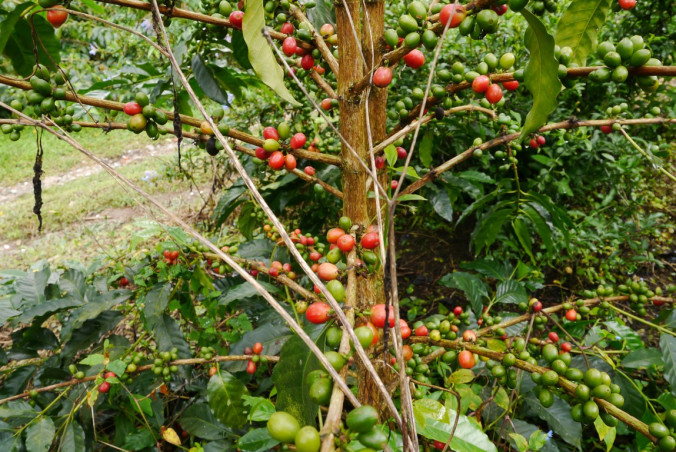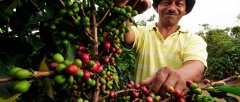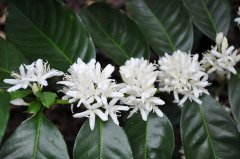Colombia coffee beans origin travel notes Colombia coffee beans cultivation picking processing record

For professional baristas, please follow the coffee workshop (Wechat official account cafe_style)
The top three coffee producing countries in the world are Brazil, Vietnam and Colombia, with three varieties, Arabica Arabica (accounting for about 70 per cent of world production), Robsta Robusta and Liberia Liberica. Colombia grows Arabica, which can only grow at a fixed altitude, just as the coffee zone in central Colombia provides the most suitable environment.
The guide gave each of us a basket tied to our waist and asked us to enter the coffee growing area within 5 minutes to harvest as many ripe fruits as possible. The fruits of most coffee trees are still unripe green, so we have to make some efforts to search for red ripe fruits, while better quality yellow fruits are fewer and harder to find. in the end, we only found the red ones, and only a few yellow fruits were harvested on the hint of the tour guide.
Arabica coffee tree
Red and green fruit, red is ripe and can be harvested
Precious yellow fruit
Harvest King Mr Smile
My achievements.. The guide said he wouldn't hire me, XD.
Occasionally a few taller varieties can only be harvested by ladders.
The guide asked us to choose the most beautiful fruit in our basket, squeeze it and suck its juice from the hole, but it was unexpectedly sweet! Then pluck away the fruit and take out the 2 seeds inside, and finally see the appearance of the coffee beans! I smelled it, and sure enough, there was no familiar smell of coffee before baking. Everyone took one of the seeds and planted them in the soil. I hope it can grow into a tree smoothly in 3-5 years.
When we arrived at the weighing area to face the cruel reality, several of us collected a total of 1 kilogram of fruit and could get a salary of about NT $8-10. In the mature season, anyone can come to collect and pay according to the weight of the harvest. A powerful collector can harvest 100 kilograms a day, which is really amazing! Then the tour guide put one kilogram of our results into a peeling machine, and the flesh can be separated automatically by rotating the roller manually.
Fresh coffee beans plucked away
Plant the seeds of hope
Weighing time!
The coffee seeds are separated into the bucket on the right.
The unwanted skin of the fruit is separated into another bucket.
After peeling, coffee beans should be soaked in water first. if the coffee beans floating on the surface may be bitten by insects or of poor quality, these coffee beans will not be discarded, but will be collected into second-class coffee beans and left in Colombia for local people to drink. All good coffee beans will be exported abroad. It's a bit sad not to be able to drink homemade high-quality coffee, but it seems to be the norm in many developing countries in order to sell it at a good price.
Then the coffee beans must be dried and can be dried in an oven or in a greenhouse dried by the sun. The real coffee beans will have to be peeled off after drying. Because the estate does not have its own machine, the beans will be sent to the nearby big city Armenia for second floor peeling and then get them back. The peeled coffee can be recycled as fuel for the oven, while the coffee beans are returned to be screened by machines or manually screened out for export, and the rest will still be left as secondary coffee.
Coffee brewing water
Drying by sunlight in a greenhouse
It can also be dried in an oven.
The second layer of peeling
Manual screening
Sharp-eyed people may find that the final screened beans are still very light, not the dark coffee beans we bought on the market. In fact, these final stage beans will be directly exported after screening, and then the desired results will be baked by each country. Finally, in retrospect, the following photos from left to right are the fruit, the seeds peeled for the first time, the seeds peeled for the second time, and the roasted coffee beans.
Finally, it's time to try it! There is no roasting machine in the coffee farm, so they all roast the coffee beans directly on the stove. for tourists, they leave some of the best quality coffee beans for us to try and buy. The guide grinds the coffee beans into powder and then uses the traditional technology, white filter cloth and boiling water to make coffee. This way reminds me that kopi in Singapore uses a similar way. Sure enough, super coffee is delicious. I don't usually drink black coffee. I also feel the sour taste of coffee. My suitcase has exploded or bought 3 packs! A solid 1.5-hour tour gives us a preliminary understanding of coffee beans, and maybe next time we can learn how to make coffee!
Important Notice :
前街咖啡 FrontStreet Coffee has moved to new addredd:
FrontStreet Coffee Address: 315,Donghua East Road,GuangZhou
Tel:020 38364473
- Prev

History story of Colombian coffee beans in the gentle countryside of Latin America Colombian coffee flavor
Exchange of professional baristas please pay attention to the coffee workshop (Wechat official account cafe_style) Latin America gentle Colombia mixed beans to present Colombia Colombian Mild as the main axis, Colombia's coffee beans are world-famous for their high quality, Arabica is the country with the highest yield, coffee trees are mostly planted in the highlands, cool and wet, which is the most favorable natural environment for coffee growth.
- Next

Colombian coffee producing area Huilan Vera province boutique coffee-the best coffee producing area in Colombia
Professional baristas Please follow the Coffee Workshop (official Wechat account cafe_style) over the past decade, Hulia has been regarded as the best and most indicative coffee producing area in Colombia, where many small farmers specialize in micro-batches of boutique coffee. In southern Colombia, each smallholder owns an average of 3 hectares of land to grow coffee.
Related
- Detailed explanation of Jadeite planting Land in Panamanian Jadeite Manor introduction to the grading system of Jadeite competitive bidding, Red bid, Green bid and Rose Summer
- Story of Coffee planting in Brenka region of Costa Rica Stonehenge Manor anaerobic heavy honey treatment of flavor mouth
- What's on the barrel of Blue Mountain Coffee beans?
- Can American coffee also pull flowers? How to use hot American style to pull out a good-looking pattern?
- Can you make a cold extract with coffee beans? What is the right proportion for cold-extracted coffee formula?
- Indonesian PWN Gold Mandrine Coffee Origin Features Flavor How to Chong? Mandolin coffee is American.
- A brief introduction to the flavor characteristics of Brazilian yellow bourbon coffee beans
- What is the effect of different water quality on the flavor of cold-extracted coffee? What kind of water is best for brewing coffee?
- Why do you think of Rose Summer whenever you mention Panamanian coffee?
- Introduction to the characteristics of authentic blue mountain coffee bean producing areas? What is the CIB Coffee Authority in Jamaica?

